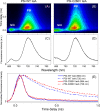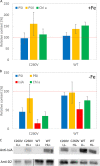A Novel Mode of Photoprotection Mediated by a Cysteine Residue in the Chlorophyll Protein IsiA
- PMID: 33593975
- PMCID: PMC8545134
- DOI: 10.1128/mBio.03663-20
A Novel Mode of Photoprotection Mediated by a Cysteine Residue in the Chlorophyll Protein IsiA
Abstract
Oxygenic photosynthetic organisms have evolved a multitude of mechanisms for protection against high-light stress. IsiA, a chlorophyll a-binding cyanobacterial protein, serves as an accessory antenna complex for photosystem I. Intriguingly, IsiA can also function as an independent pigment protein complex in the thylakoid membrane and facilitate the dissipation of excess energy, providing photoprotection. The molecular basis of the IsiA-mediated excitation quenching mechanism remains poorly understood. In this study, we demonstrate that IsiA uses a novel cysteine-mediated process to quench excitation energy. The single cysteine in IsiA in the cyanobacterium Synechocystis sp. strain PCC 6803 was converted to a valine. Ultrafast fluorescence spectroscopic analysis showed that this single change abolishes the excitation energy quenching ability of IsiA, thus providing direct evidence of the crucial role of this cysteine residue in energy dissipation from excited chlorophylls. Under stress conditions, the mutant cells exhibited enhanced light sensitivity, indicating that the cysteine-mediated quenching process is critically important for photoprotection.IMPORTANCE Cyanobacteria, oxygenic photosynthetic microbes, constantly experience varying light regimes. Light intensities higher than those that saturate the photosynthetic capacity of the organism often lead to redox damage to the photosynthetic apparatus and often cell death. To meet this challenge, cyanobacteria have developed a number of strategies to modulate light absorption and dissipation to ensure maximal photosynthetic productivity and minimal photodamage to cells under extreme light conditions. In this communication, we have determined the critical role of a novel cysteine-mediated mechanism for light energy dissipation in the chlorophyll protein IsiA.
Keywords: Synechocystis; cyanobacteria; energy dissipation; photoprotection; photosynthesis.
Copyright © 2021 Chen et al.
Figures







Similar articles
-
Introduction of cysteine-mediated quenching in the CP43 protein of photosystem II builds resilience to high-light stress in a cyanobacterium.Biochim Biophys Acta Bioenerg. 2022 Oct 1;1863(7):148580. doi: 10.1016/j.bbabio.2022.148580. Epub 2022 May 30. Biochim Biophys Acta Bioenerg. 2022. PMID: 35654167
-
Reevaluating the mechanism of excitation energy regulation in iron-starved cyanobacteria.Biochim Biophys Acta Bioenerg. 2017 Mar;1858(3):249-258. doi: 10.1016/j.bbabio.2017.01.001. Epub 2017 Jan 8. Biochim Biophys Acta Bioenerg. 2017. PMID: 28077273
-
Identification of common motifs in the regulation of light harvesting: The case of cyanobacteria IsiA.Biochim Biophys Acta. 2015 Apr-May;1847(4-5):486-492. doi: 10.1016/j.bbabio.2015.01.003. Epub 2015 Jan 21. Biochim Biophys Acta. 2015. PMID: 25615585
-
Structure and functional role of supercomplexes of IsiA and Photosystem I in cyanobacterial photosynthesis.FEBS Lett. 2005 Jun 13;579(15):3253-7. doi: 10.1016/j.febslet.2005.03.051. Epub 2005 Apr 7. FEBS Lett. 2005. PMID: 15943969 Review.
-
Protective dissipation of excess absorbed energy by photosynthetic apparatus of cyanobacteria: role of antenna terminal emitters.Photosynth Res. 2008 Sep;97(3):195-204. doi: 10.1007/s11120-008-9336-8. Epub 2008 Aug 22. Photosynth Res. 2008. PMID: 18720026 Review.
Cited by
-
Energetic robustness to large scale structural fluctuations in a photosynthetic supercomplex.Nat Commun. 2023 Aug 2;14(1):4650. doi: 10.1038/s41467-023-40146-8. Nat Commun. 2023. PMID: 37532717 Free PMC article.
-
Regulation and Functional Complexity of the Chlorophyll-Binding Protein IsiA.Front Microbiol. 2021 Nov 17;12:774107. doi: 10.3389/fmicb.2021.774107. eCollection 2021. Front Microbiol. 2021. PMID: 34867913 Free PMC article. Review.
-
Identification and design principles of far-red-absorbing chlorophyll in the light-harvesting complex.J Biol Chem. 2025 Jun;301(6):108518. doi: 10.1016/j.jbc.2025.108518. Epub 2025 Apr 18. J Biol Chem. 2025. PMID: 40254256 Free PMC article.
-
Annihilation of Excess Excitations along Phycocyanin Rods Precedes Downhill Flow to Allophycocyanin Cores in the Phycobilisome of Synechococcus elongatus PCC 7942.J Phys Chem B. 2022 Jan 13;126(1):23-29. doi: 10.1021/acs.jpcb.1c06509. Epub 2022 Jan 4. J Phys Chem B. 2022. PMID: 34982932 Free PMC article.
-
Inhomogeneous energy transfer dynamics from iron-stress-induced protein A to photosystem I.Front Plant Sci. 2024 May 16;15:1393886. doi: 10.3389/fpls.2024.1393886. eCollection 2024. Front Plant Sci. 2024. PMID: 38817933 Free PMC article.
References
-
- Martin JH, Fitzwater SE. 1988. Iron-deficiency limits phytoplankton growth in the Northeast Pacific Subarctic. Nature 331:341–343. doi:10.1038/331341a0. - DOI
-
- Moore CM, Mills MM, Arrigo KR, Berman-Frank I, Bopp L, Boyd PW, Galbraith ED, Geider RJ, Guieu C, Jaccard SL, Jickells TD, La Roche J, Lenton TM, Mahowald NM, Marañón E, Marinov I, Moore JK, Nakatsuka T, Oschlies A, Saito MA, Thingstad TF, Tsuda A, Ulloa O. 2013. Processes and patterns of oceanic nutrient limitation. Nat Geosci 6:701–710. doi:10.1038/ngeo1765. - DOI
-
- Vrede T, Tranvik LJ. 2006. Iron constraints on planktonic primary production in oligotrophic lakes. Ecosystems 9:1094–1105. doi:10.1007/s10021-006-0167-1. - DOI
-
- North R, Guildford S, Smith R, Havens S, Twiss M. 2007. Evidence for phosphorus, nitrogen, and iron colimitation of phytoplankton communities in Lake Erie. Limnol Oceanogr 52:315–328. doi:10.4319/lo.2007.52.1.0315. - DOI
Publication types
MeSH terms
Substances
LinkOut - more resources
Full Text Sources
Other Literature Sources
